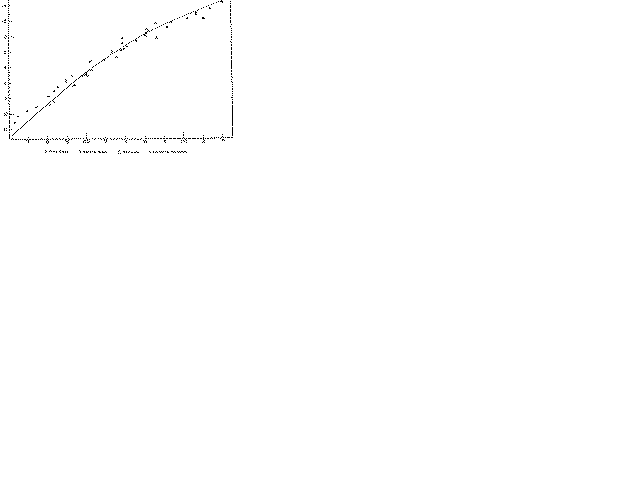- us; for example, if you were inside Capella you would not notice the material of Capella any more than you notice the air in this room. For gaseous stars, then, the investigation will give formulae by which, given the mass of the star, we can calculate how much energy of heat and light will leak out of it -- in short, how bright it will be. In Fig. 7 a curve is drawn giving this theoretical relation between the brightness and mass of a star. Strictly speaking, there is another factor besides the mass which affects the calculated brightness; you can have two stars of the same mass, the one dense and the other puffed out, and they will not have quite the same brightness. But it turns out (rather unexpectedly) that this other factor, density, makes very little difference to the brightness, always provided that the material is not too dense to be a perfect gas. I shall therefore say no more about density in this brief summary.
 Fig 7. The Mass-luminosity Curve
Fig 7. The Mass-luminosity Curve Here are a few details about the scale of the diagram. The brightness is measured in magnitudes, a rather technical unit. You have to remember that stellar magnitude is like a golfer's handicap -- the bigger the number, the worse the performance. The diagram includes practically the whole range of stellar brightness; at the top -4 represents almost the brightest stars known, and at the bottom 12 is nearly the faintest limit. The difference from top to bottom is about the same as the difference between an arc light and a glow worm. The sun is near magnitude 5. These magnitudes refer, of course, to the true brightness, not to the apparent brightness affected by distance; also, what is represented here is the 'heat brightness' or heat intensity, which is sometimes a little different from the light intensity. Astronomical instruments have been made which measure directly the heat instead of the light received from a star. These are quite successful; but there are troublesome corrections on account of the large absorption of heat in the earth's atmosphere, and it is in most cases easier and more accurate to infer the heat brightness from the light brightness, making allowance for the colour of the star. The horizontal scale refers to mass, but it is graduated according to the logarithm of the mass. At the extreme left the mass is about 1/6 x sun, and on the extreme right about 30 x sun; there are very few stars with masses outside these limits. The sun's mass corresponds to the division labelled 0.0.
Having obtained our theoretical curve, the first thing to do is to test it by observation. That is to say, we gather together as many stars as we can lay hands on for which both the mass and absolute brightness have been measured. We plot the corresponding points (opposite to the appropriate horizontal and vertical graduations) and see whether they fall on the curve, as they ought to do if the theory is right. There are not many stellar masses determined with much precision. Everything that is reasonably trustworthy has been included in Fig. 7. The circles, crosses, squares, and triangles refer to different kinds of data -- some good, some bad, some very bad.
The circles are the most trustworthy. Let us run through them from right to left. First comes the bright component of Capella, lying beautifully on the curve because I drew the curve through it. You see, there was one numerical constant which in the present state of our knowledge of atoms and ether-waves, &c., it was not possible to determine with any confidence from pure theory. So the curve when it was obtained was loose in one direction and could be raised or lowered. It was anchored by making it pass through the bright component of Capella which seemed the best star to trust to for this purpose. After that there could be no further tampering with the curve. Continuing to the left we have the fainter component of Capella; next Sirius; then, in a bunch, two components of
Centauri (the nearest fixed star) with the Sun between them , and -- lying on the curve -- a circle representing the mean of six double stars in the Hyades. Finally, far on the left there are two components of a well known double star called Krueger 60. The observational data for testing the curve are not so extensive and not so trustworthy as we could wish; but still I think it is plain from Fig. 7 that the theory is substantially confirmed, and it really does enable us to predict the brightness of a star from its mass, or vice versa. That is a useful result, because there are thousands of stars of which we can measure the absolute brightness but not the mass, and we can now infer their masses with some confidence.
| Previous chapter/page | Back | Home | Email this | Search | Discuss | Bookmark | Next chapter/page |